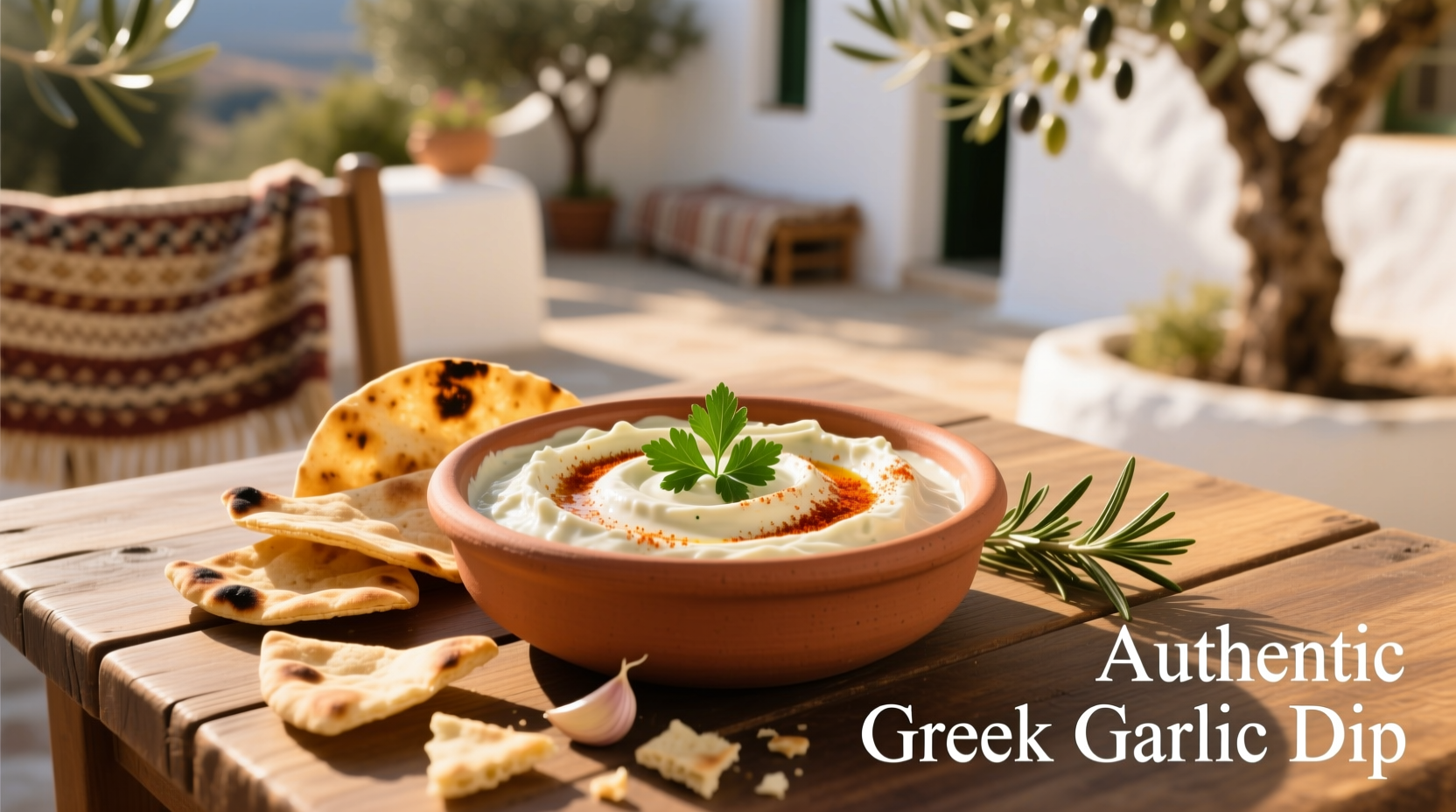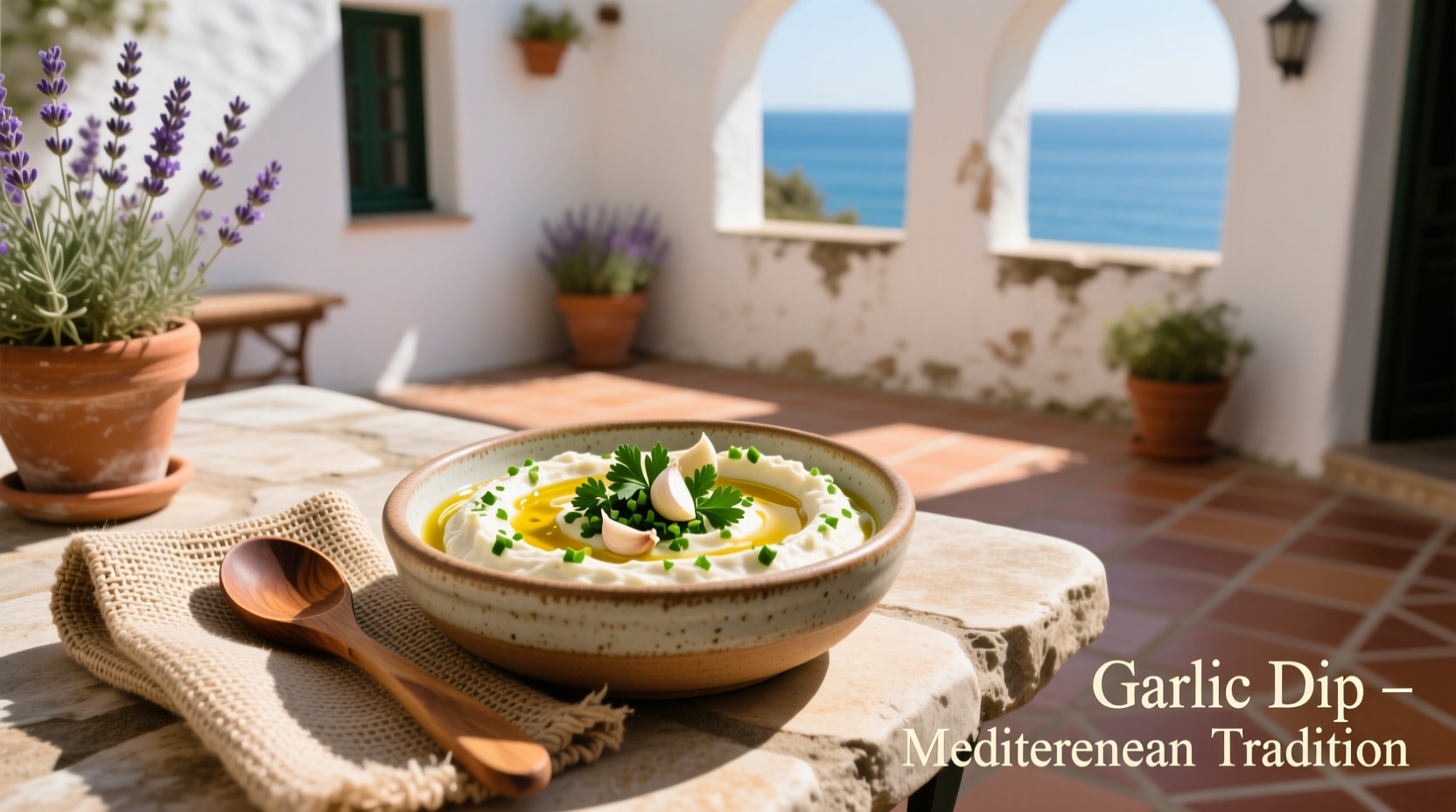Why This Mediterranean Garlic Dip Recipe Gets It Right
Most "Mediterranean" garlic dips miss the mark with artificial flavors and processed ingredients. This authentic version captures the bright, complex flavors found in seaside tavernas across the region. You'll learn the proper emulsion technique that creates that signature creamy texture without mayo, plus regional variations that transform this simple dip into something extraordinary.
The Mediterranean Garlic Dip Essentials
True Mediterranean garlic dip (known as skordalia in Greece, çemen in Turkey, and thoom in Lebanon) centers around three non-negotiable elements: fresh garlic, high-quality olive oil, and acidity from lemon juice or vinegar. The magic happens through proper emulsification—slowly incorporating oil into the garlic base to create that luxurious, creamy texture without dairy.
| Regional Variation | Key Ingredients | Texture | Traditional Pairings |
|---|---|---|---|
| Greek Skordalia | Garlic, olive oil, lemon, potato or nuts | Thick, creamy | Fried fish, beets, bread |
| Turkish Çemen | Garlic, olive oil, paprika, vinegar | Smooth, slightly runny | Meat dishes, grilled vegetables |
| Lebanese Thoom | Garlic, olive oil, lemon, tahini | Rich, velvety | Grilled meats, falafel, pita |
This comparison shows how Mediterranean cultures have adapted garlic dip to local ingredients while maintaining the essential garlic-olive oil foundation. According to culinary historian Claudia Roden's research on Mediterranean food traditions, these variations emerged from ancient preservation techniques where garlic and oil created antimicrobial properties for food safety (Encyclopedia Britannica, 2023).
Step-by-Step Preparation Guide
Creating authentic Mediterranean garlic dip requires attention to technique more than ingredients. Follow these steps for perfect results every time:
What You'll Need
- 4-6 fresh garlic cloves (adjust to taste)
- 1 cup extra virgin olive oil (Greek or Spanish preferred)
- 2 tablespoons fresh lemon juice
- 1 teaspoon sea salt
- 1-2 tablespoons water or regional base (tahini, yogurt, or potato)
The Emulsion Process
- Peel and mince garlic cloves finely, then mash with salt into a paste using a mortar and pestle
- Slowly drizzle in olive oil while continuously whisking—this gradual incorporation creates the emulsion
- Add lemon juice and regional base ingredient (tahini for Lebanese style, boiled potato for Greek)
- Continue whisking until thick and creamy (about 5 minutes)
- Adjust consistency with cold water if too thick
The critical step is the oil incorporation—adding it too quickly breaks the emulsion. Professional chefs in Mediterranean regions typically spend 5-7 minutes creating the proper texture through slow, steady drizzling. This technique makes all the difference between a separated, oily mess and that signature creamy consistency.

Serving and Storage Tips
Mediterranean garlic dip tastes best when served at room temperature, allowing the olive oil flavors to shine. For authentic presentation:
- Drizzle with additional olive oil and sprinkle with paprika or fresh herbs
- Serve with warm pita bread, fresh vegetables, or traditional pairings like fried eggplant
- Store in an airtight container in the refrigerator for up to 5 days
Important note: The garlic flavor intensifies over time. If making ahead for an event, prepare the dip 24 hours in advance for optimal flavor development. Bring to room temperature 30 minutes before serving for the best texture and aroma.
Troubleshooting Common Issues
Even experienced cooks encounter challenges with garlic dip. Here's how to fix the most common problems:
Broken Emulsion
If your dip separates, start with a fresh egg yolk or 1 tablespoon of tahini in a clean bowl, then slowly whisk in the broken mixture. The additional emulsifier will bring it back together.
Too Strong Garlic Flavor
Balance intense garlic by adding more lemon juice and olive oil. For immediate relief, mix in 1-2 tablespoons of plain yogurt which neutralizes the sharpness while maintaining creaminess.
Dip Too Thick
Add cold water one teaspoon at a time while whisking until desired consistency. Avoid using more oil as this dilutes flavor. For Greek-style skordalia, a small amount of the potato cooking water works perfectly.
Regional Variations Worth Trying
Once you've mastered the basic technique, experiment with these authentic regional twists:
Greek Skordalia with Walnut Base
Traditional in coastal regions, this version uses soaked walnuts instead of potatoes for a richer flavor. Soak 1/4 cup walnuts in water for 2 hours, then blend with garlic before emulsifying with oil.
Turkish Çemen with Isot Pepper
Add 1 teaspoon of isot biber (Turkish red pepper) for smoky depth. This variation often includes a splash of vinegar instead of lemon for brighter acidity.
Lebanese Thoom with Pine Nuts
Toast 1 tablespoon pine nuts and fold into finished dip for texture contrast. The tahini base creates a smoother emulsion that holds up well with grilled meats.
Why Fresh Ingredients Matter
The simplicity of Mediterranean garlic dip means ingredient quality directly impacts the final result. Research from the International Olive Council shows that extra virgin olive oil contains over 30 phenolic compounds that contribute to both flavor and health benefits (International Olive Council, 2024). Using fresh garlic (rather than pre-minced) provides allicin, the compound responsible for garlic's distinctive flavor and health properties.
When selecting ingredients:
- Choose firm, plump garlic cloves without green sprouts
- Look for olive oil with a harvest date within the last 12 months
- Use freshly squeezed lemon juice—bottled versions alter the delicate balance











 浙公网安备
33010002000092号
浙公网安备
33010002000092号 浙B2-20120091-4
浙B2-20120091-4